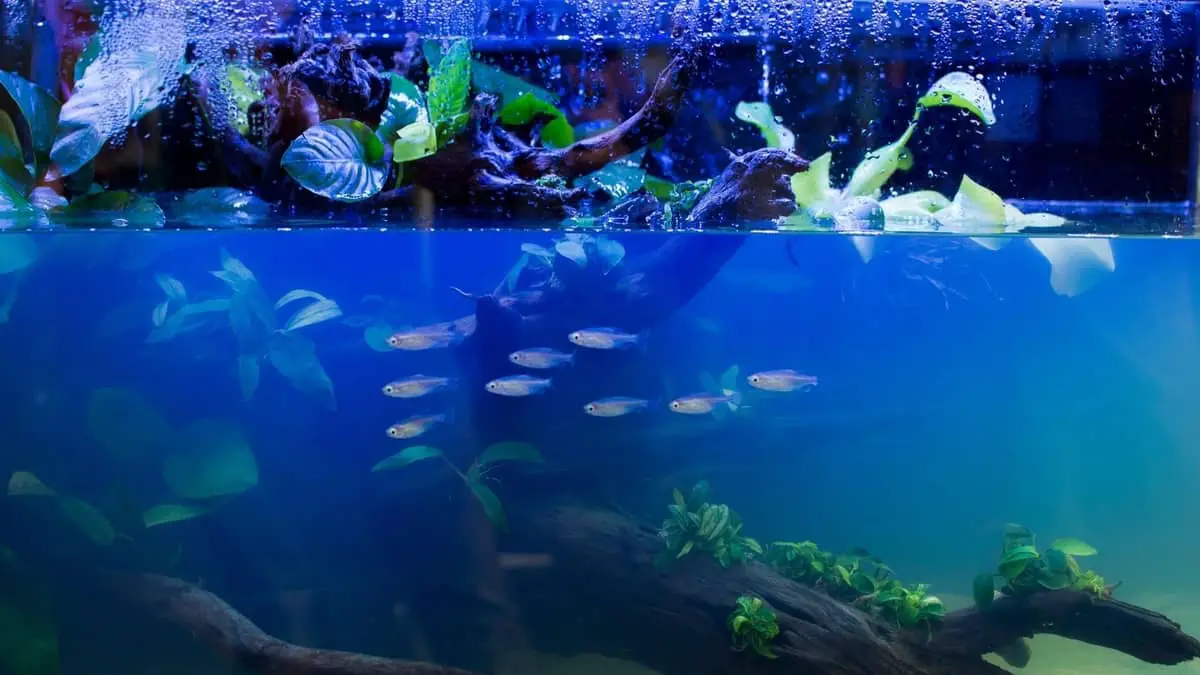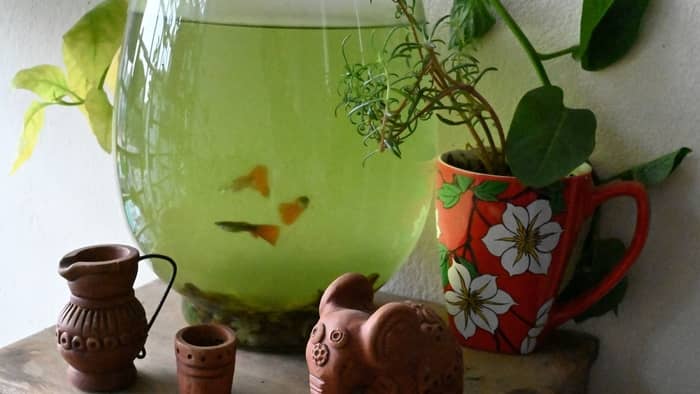Last Updated on January 20, 2022 by admins
If you have fish, you’ve likely asked yourself, what makes aquarium water cloudy? A cloudy fish tank is not only annoying, but it is also problematic. Fortunately, there are many solutions to this annoying issue.
If you are experiencing a cloudy fish tank, don’t worry, as this is a common problem. Many people at some point or another struggle with a cloudy aquarium. By learning what is causing the cloudiness you can then figure out how to resolve the issue.
What Makes Aquarium Water Cloudy?
There are many reasons that aquarium water can be cloudy, which is frustrating. However, based on certain aspects, such as the color, you can determine the cause behind the cloudiness. This will not only make your aquarium look better, but will also provide a healthier environment for your fish.
White Or Gray Cloudiness
One of the most common colors of cloudiness is white or gray. Fortunately, when it is this color it is often an easy fix.
Gravel Residue
One of the most common causes of cloudiness in a tank is gravel residue, which generally occurs within one to two hours of filling. This often occurs when new gravel is put into a tank. It is particularly common if the gravel has not been washed properly before putting in the tank.
High Level Of Dissolved Constituents
It is not uncommon for phosphates, silicates, or heavy metals to find their way into your aquarium water as dissolved constituents. These can commonly be found in tap water, which many experts recommend avoiding for your fish tank.
This generally happens right after you fill your tank with water. You will likely also notice that your water has high pH levels when this happens.
Bacteria Bloom
Bacterial bloom is one of the most common reasons for cloudy tank water. It can occur days, weeks, or even months after setting up your aquarium. The process happens as your tank’s biological filter system matures.
Bacteria bloom is actually a beneficial aspect of your aquarium environment. The bacteria break down fish waste, decaying debris from plants and unconsumed food then turns it into ammonia. Due to the fact that the heterotrophs multiply quickly, their growth can cause the water to become cloudy.
Read more about: How To Get Rid Of Blue-Green Algae In A Planted Aquarium
Yellowish/Brown Tint
A yellowish/brown tint is not uncommon in water. However, there are generally only a couple of reasons that can cause this.
Too Much Food
If you are overfeeding your fish, the excess food may begin to dissolve. This can create cloudiness in your water that is often yellow or brown.
Dirty Tank
Over time, algae, fish food, and waste can build up in your aquarium. If you don’t clean your tank on a regular basis, it can cause cloudiness in your tank.
Green Tint
You may notice that your aquarium has developed a green tint. This can be very agitating, however, it can be fixed.
Algae Growth
Algae growth is normal in aquariums. However, over time excess algae growth can lead to a green tint in your water.
Phosphates
Phosphates can come from dissolving food or even just the water itself. Certain water has a naturally higher level of phosphates. An excess of phosphate can create a green tint.
Nitrates
Nitrates are a natural byproduct of fish waste in aquariums. As they build up over time, they begin to create a green tint.
Learn more about: Lowering Nitrates In A Freshwater Aquarium
How To Clear Up Cloudy Aquarium Water
Once you pinpoint the cause is of the cloudiness in your aquarium, you can work on stopping and preventing it. Cloudy water in a freshwater aquarium is a common occurrence and there are several ways to resolve it.
Thoroughly Clean Your Gravel
Before adding gravel to your tank, thoroughly wash it. Washing it will help remove any residue that can cause cloudiness. Keep watching the gravel until the water runs clear.
Regularly Clean Your Tank
In order to eliminate any excess waste, food, or algae the filter doesn’t get, regularly clean your tank. You should aim to clean your tank once a week.
Find more information about How To Clear Green Aquarium Water?
Avoid Tap Water
Tap water can be full of dissolved concentrates such as phosphates, silicates, or heavy metals. Since this can cause cloudiness, among other problems, it is best to avoid tap water.
Don’t Overfeed Your Fish
When overfeeding your fish, the excess food can begin to break down. This then leads to cloudiness and can be problematic for your fish. Be sure to feed only the right amount of food your fish need.
Don’t Have Too Many Fish
Too many fish in a tank can lead to an excess of waste in your tank, which can make the water murky. Be sure to not have too many fish in your tank.
Limit Light Exposure
Light exposure can increase algae growth which can give water a greenish tint. Be sure not to place your aquarium in an area where there is no direct sunlight.
Replace The Water
In some cases, such as when phosphates or nitrates build up, it is best to replace the water. When replacing the water, only replace 30% of the water at a time.
What Causes Cloudiness and How To Get Rid Of Cloudy Aquarium Water
Whether white, gray, yellow, brown, or green, it is not uncommon for water in aquariums to be cloudy. The cloudiness can be unattractive, annoying, and even problematic. Fortunately, there are many ways you can prevent cloudiness in your fish tank to provide a clean and healthy environment.
Be certain to wash your gravel, regularly clean your fish tank, avoid tap water, don’t overfeed, and don’t have too many fish in your tank. In addition, limit light exposure to decrease algae growth and replace the water on a regular basis. However, in the case of bacteria bloom, you shouldn’t do anything to stop the cloudiness as the bacteria are beneficial to the environment of the tank.
Do you have any questions on what makes aquarium water cloudy? If so, please ask any questions about cloudiness in aquariums and how to treat it in the comment section down below.

